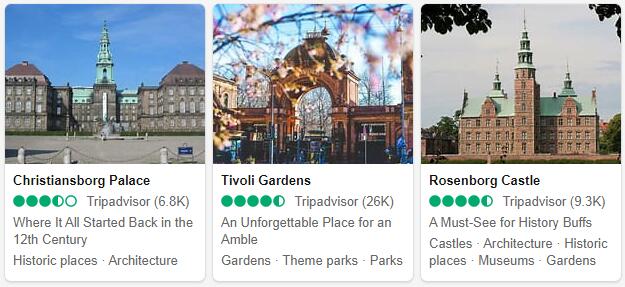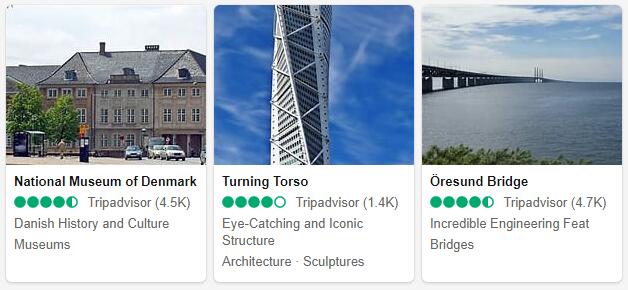
Attractions in Copenhagen
There are numerous attractions and sights in Copenhagen. They range from cultural attractions in the form of art and music, to beautiful magnificent buildings and ingenious museums we do not have in Norway. Perhaps the most famous and well-known are the little mermaid lying at Langelinie, see the picture above.
City Hall and City Hall Square
One of the great things in Copenhagen is the City Hall. Construction of the town hall began in 1892, and it was completed in 1905. The style is a mix of Renaissance from Italy and Danish medieval architecture. The material selection is of exquisite quality and the decoration is beautiful and lavish.
Within the main entrance of the town hall you will find Jens Olsen’s World Clock, which has the time for all continents. The Town Hall Square itself is Copenhagen’s navel and clearly inspired by squares in Italian cities.
Tivoli in Copenhagen
Tivoli is located south of City Hall Square. The area is an invitation to romance, party and fun. Music has always been a part of Tivoli, and everything from jazz and rock to classical music is played. Tivoli also offers a number of restaurants, but it is the pleasure activities that dominate. Tivoli is mainly open from early April to the end of September. From mid-November until little Christmas Eve, however, there is a Christmas market at Tivoli, which is very popular.
Zoological Museum
This beautiful museum is located in the University Park (no. 15) and was planned for approx. 350 years ago. Today, the Zoological Museum is one of the most modern and best in Europe in terms of zoology.
Here you will find stuffed animals, bone remnants and dinosaur exhibits as well as several exciting activities.
Zoo
This zoo from 1859 has developed into one of Copenhagen’s major attractions. You will find tropical rainforests and African savannas with many beautiful animals. They also have a zoo for the smallest children where they can pet farm animals. The zoo is located in Frederiksberg, more specifically Roskildevej 32.
Guinness World of Record Museum
Most people are familiar with the book The Guiness World of Records? This museum exemplifies and demonstrates many of the marvelous records in the world. The address is Østergade 16, right by Strøget.
Ripley’s Believe It Or Not Museum
This somewhat humorous museum can be found at City Hall Square 57. The museum contains 1000 square meters of incredible things and real-life things. It is e.g. shrunken heads from cannibals in South America, the two-headed calf and what the Scots really have under the kilts.
The Storm P. Museum
For those who have not yet been fortunate enough to get acquainted with Storm P., we can tell that it is an admired and dearly-loved cartoonist, writer and humorist who all Danes (and Scandinavians) have pressed to their chest. The Storm P. Museum displays many of his works and is a guarantor of good humor.
The museum is open all year from 7 pm. 1000 to 1600, but only on Wednesdays, Saturdays and Sundays between November and April. The address is Frederiksberg Roundabout.
National Museum
This is Denmark’s main cultural history museum and is located on Frederiksholm’s canal 12. The museum is open at. 1000-1700 every day except Mondays, when it is closed. The National Museum has great exhibits showing finds from ancient to modern times. The museum also has its own children’s section.
Amalienborg Museum and Amalienborg Castle
If you are interested in royal families, furniture and architecture, this is the place for you. The four Amalienborg castles were built in the middle of the 18th century and became the residence of the royals from 1794. The museum is located at Amalienborg, Christian VIII’s Palace.
Marble Churches (Frederikskirken)
Frederikskirken is a very special church. It was designed in 1740 and got the foundation stone laid in 1749. The marble church has an impressive balustrade as well as beautiful statues of famous church fathers.
You will find this stately church in Frederiksgade 4.
Our Savior’s Church
This church is a landmark in Copenhagen, not least because the tower is 95 meters high and offers breathtaking views. NB! The tower is closed between November and April. Our Savior’s Church is in Baroque style and is world renowned for its church organ and beautiful Baroque ages. The address is Sankt Annæ Gade 29.
Rundetårn
The Round Tower is a science center created by Christian IV as early as 1642. Here you can look into starguns and observe planets and other celestial bodies. Included in the purchase are great views of Copenhagen. The address is KobmagerGade 52 A.
Rosenborg Castle
At the King’s Garden, in particular Øster Voldgade 4 A, lies this magnificent castle. Originally, Rosenborg Castle was built as a summer residence for King Christian IV in the early 17th century. You may not know that this is where the Danish crown jewels are stored?
swim center
This is a different swimming pool. There is really no limit to what you can do here. You can get involved in different types of pools, you can climb climbing walls, relax in hot pools or have a spa treatment.
Perhaps the finest swimming pool in the Nordic countries. The address is Tietgensgade 65 southwest of Tivoli.
Tourist in Copenhagen
When you visit Copenhagen, relax and enjoy life. It does not mean that you will not experience much, but here there is no need to stress around. It’s amazing how much you want to bring with you anyway.
Day 1 in Copenhagen
The natural starting point in Copenhagen is, of course, the Town Hall Square, where the magnificent Siena-inspired city hall stands in a mix of Italian Renaissance style and Danish medieval architecture. Walk down Strøget (Fredriksberggade) until you reach Gammel Torv and Nytorv. Here you take Nørregade past Old Torv. You will now quickly reach the Cathedral, or Our Lady Church as it is also called. There have been churches here since the 1100s, but as you will see from the neoclassical style, today’s church was inaugurated at the end of the 1820s. There is free entrance to the church.
Tsar Peter and the Round Tower in Copenhagen
Walk around the church to Our Lady Square and walk up St. Kannikestræde until you reach the Round Tower and Trinitatis Church in BUYMAGERGADE. The round tower was erected as an observatory in the mid-17th century. The wind speed in the tower is 209 meters, which may sound strange, since the tower is only 36 meters high. The reason is that you had to manage to carry heavy observation equipment to the top. From the top there is a great view of Copenhagen. Czar Peter the Great himself must have ridden up the winding corridor to the top to look at the view.
Go now Købmagergade down the Stroget again. You will then come straight to Amagertorv. Here, people are usually at their most intense with street artists and shopping people out and in and out of the ranks of shops and department stores.
Follow Strøget north and take time to take a closer look at Nikolaj Church on Nikolaj Square (east of Strøget). The magnificent tower you see is originally from 1591, while the spire was donated in 1910. The church building is today the home of various exhibitions. When you are back on Strøget, continue north until you reach Kongens Nytorv. Here you will find a number of beautiful buildings as well as fun museums such as Guinness World of Records and The Mystic Exploratorie (Østergade 16). Take time for the area’s attractions before continuing to Nyhavn (just east of Kongens Nytorv). Relax at one of the many restaurants with a better lunch.
Beautiful Amalienborg in Copenhagen
After lunch and relaxation you can return to Kongens Nytorv and follow Bredgade to Amalienborg and the king’s castle. The castle grounds are very beautiful, and the castle museum can be an alternative if you want more knowledge about the royal family and the splendid buildings here. If not, we suggest that you cross Bredegade and take a closer look at the beautiful Marble Church or Frederik’s Church.
This church got its foundation stone from Frederick V in 1749. The church is a typical Roman Baroque church, and the copper dome can be reminiscent of St. Peter’s Church in Rome. On the balustrade you will see 16 statues of great religious figures. On the pedestals you will find statues of famous Danish church personalities.
End the tour by continuing west until you reach the King’s Garden (Rosenborg Garden) and Rosenborg Castle. This magnificent pleasure castle was built for Christian IV and was completed for the first time in 1617. Various extensions meant that construction work only stopped in 1634. The castle today houses the Rosenborg collections with the magnificent crown jewels in their treasury.
In the evening we suggest that you experience a real Danish inn and the mood there. A great alternative could be Café Lindevang at PG Ramms Allé 4. The place normally closes at. 2100. Call 38 34 38 34 for reservation.
Day 2 in Copenhagen
After a hopefully very enjoyable evening in the city of Copenhagen, start the day with a good breakfast at the hotel before embarking on your shopping trip. As always, City Hall Square is a good start to the day. The pedestrian zone is in many ways the major shopping street in Copenhagen, and the prices closest to the Town Hall square are the most reasonable. As you move closer to Kongens Nytorv, prices rise in line with more fashionable stores. When you have come so far that you are at Østergade in Strøget, the shopping center Det Ny Illum (no. 52) is well worth a visit.
Go to Amagertorv and follow BUYMAGERGADE westwards. Here you will find both specialty shops and fashion shops. At the same time, several of the side streets, e.g. the street Klareboderne, a number of small pearls of shops, especially in design. Work your way up Købmagergade until you reach the Kul Torvet. Walk west until you are in Fiolstræde. Here are many exciting antiques and bookshops, and also some specialty clothing stores. Follow Fiolstræde until you are back in Strøget and return to Rådhusplatsen.
If you have not yet lost the shopping spark, we suggest you continue a little south of the Town Hall square and take a look in Vesterbrogade and the small streets Studiestræde and Larsbjørnsstræde, which is also just southwest of City Hall Square.
Copenhagen is Tivoli
Afternoon and evening must be spent at Tivoli. Tivoli is located south of the Town Hall Square and opposite Vesterbrogade. Tivoli is romance, party, entertainment and a guarantor for a pleasant evening. Music has always been a part of Tivoli, and everything from jazz and rock to classical music is played.
Tivoli also offers a number of restaurants offering everything from local cuisine to many different international cuisines. You should also not be afraid not to find a restaurant that suits you at a price. Here they are in all price ranges and types. Beyond this, of course, the entertainment activities dominate Tivoli. Carousels, roller coasters, activity houses, booths and everything else. And new attractions come every year.
Tivoli is mainly open from early April to the end of September. From mid-November until little Christmas Eve, however, there is a Christmas market at Tivoli, which is very popular.
If you are visiting Copenhagen out of season for Tivoli, we suggest you spend the afternoon at one of Copenhagen’s good and interesting museum exhibitions. We propose the National Museum, which is located at Frederiksholms canal 12. The museum is open from 10am. 1000 to 1700 every day except Mondays, when it is closed. The National Museum has great exhibits showing finds from ancient to modern times. The museum also has its own children’s section. In addition, it is located in a very nice area with many other sights.
